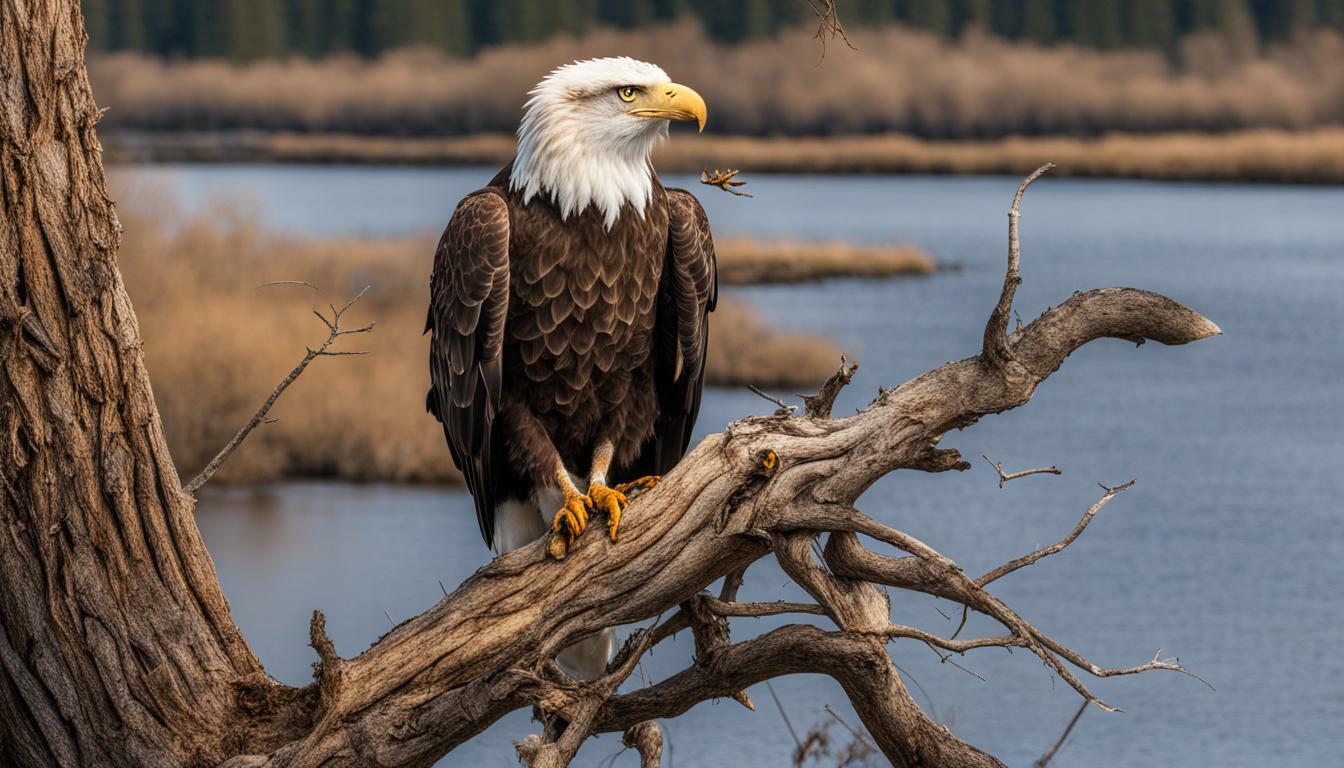Have you ever wondered if bald eagles include coyotes in their diet? With their impressive wingspan and sharp talons, bald eagles are formidable predators that are known for their ability to hunt a wide range of prey. In this section, we will explore the intriguing question of whether bald eagles eat coyotes. By understanding their feeding habits and hunting behavior, we can gain valuable insights into the relationship between these majestic birds and coyotes.
Key Takeaways
- Bald eagles are apex predators that are known for their impressive hunting skills.
- While they primarily target fish and smaller prey, bald eagles have been known to consume a wide range of animals.
- The consumption of coyotes by bald eagles is relatively rare, but has been observed in some instances.
- Understanding the factors that influence bald eagles’ dietary decisions can help us gain valuable insights into their interactions with other species.
Bald Eagles’ Diet: An Overview
If you’re curious about whether bald eagles eat coyotes, it’s essential to understand their general diet. Bald eagles are opportunistic hunters and scavengers and will consume a variety of prey, from fish to small mammals, birds, and even carrion.
Fish make up a significant portion of a bald eagle’s diet, with water-dwelling creatures such as salmon, trout, and herring being common targets. These birds are also known to prey on smaller mammals such as rabbits, squirrels, and rodents.
When it comes to birds, bald eagles will target waterfowl, such as ducks and geese, as well as shorebirds, gulls, and seabirds. They may also consume turtles and crustaceans.
It’s important to note that bald eagles’ diet may vary depending on their geographic location and the availability of prey in their habitat.
Bald Eagle Feeding Behavior
Understanding the feeding behavior of bald eagles is essential in determining whether they might consider coyotes as prey. These birds primarily use two hunting techniques; perch hunting and soaring. Perch hunting involves waiting for a prey animal to come within range while perched on a high vantage point, such as a tree or rock. Soaring involves flying over an area in search of prey from a high altitude.
When targeting fish, bald eagles typically use their powerful talons to grab the fish while flying low over the water. They may also snatch fish from the surface of the water or steal them from other birds.
When it comes to land-based prey, bald eagles tend to target smaller animals such as rabbits, squirrels, and rodents. They may also prey on waterfowl such as ducks and geese, as well as carrion such as dead animals.
While bald eagles have been known to attack larger land animals such as deer and goats, these instances are rare and usually occur when other food sources are scarce.
The feeding behavior of bald eagles suggests that they would not actively seek out coyotes as prey. However, if a bald eagle were to come across a weakened or injured coyote, it is possible that they may consider it as an opportunistic meal.
Bald Eagle Hunting Habits
Bald eagles are opportunistic predators known for their hunting prowess. They typically target fish found in freshwater bodies such as lakes, rivers, and marshes. However, these birds also hunt other animals, including mammals, birds, and reptiles, depending on availability and need.
To catch their prey, bald eagles use several hunting techniques, such as perching, soaring, and flying close to the surface of the water. They also hunt cooperatively, with some eagles driving prey towards another eagle lying in wait.
Bald Eagle Hunting Habits: A Closer Look
Bald eagles employ various hunting strategies tailored to their environment and the prey species they target. When hunting fish, they typically fly over water bodies and scan for potential prey with their keen eyesight. Once they spot a fish, they dive into the water, using their talons to grasp the fish, and then fly to a safe location to eat.
When hunting mammals, bald eagles often use perching as a hunting technique. They perch on high structures such as trees, cliffs, or buildings, and scan the surrounding area for potential prey. They also fly closely over the ground when hunting small mammals and use cooperative hunting methods when targeting larger prey.
Overall, bald eagles are skilled hunters that use their agility, intelligence, and adaptability to find and catch prey. However, their hunting habits do not typically include coyotes as a significant part of their diet.
The Relationship Between Bald Eagles and Coyotes
Living in the same habitats, coyotes and bald eagles often cross paths. However, the relationship between these animals is complex and multifaceted. It is important to explore the interactions and dynamics between these two species to determine whether bald eagles view coyotes as part of their natural prey.
Bald eagles are known to be territorial and often defend their nesting sites fiercely. Coyotes may occasionally scavenge eagle nests for food, leading to conflict between the two species. Additionally, coyotes may pose a threat to eaglets and other small birds, which bald eagles protect within their territories.
The Influence of Habitat on Interaction
The relationship between these two species may vary based on the habitat in which they are found. For example, in coastal areas, bald eagles may rely heavily on fish as their primary source of food, reducing the likelihood of interaction with coyotes. Conversely, in habitats where fish populations are scarce, bald eagles may turn to other prey, including small mammals such as coyotes.
The Role of Competition
Competition for food and resources may also influence the relationship between bald eagles and coyotes. When prey is abundant, these two species may coexist without conflict. However, when resources are scarce, competition between the two animals may occur, leading to potential predation.
Overall, while the relationship between bald eagles and coyotes is complex, it is unlikely that coyotes are a significant part of a bald eagle’s diet. Bald eagles primarily target fish and smaller prey, and instances of bald eagles consuming coyotes are rare. Nevertheless, the occasional predation on a coyote by a bald eagle cannot be entirely discounted.
Predation by Bald Eagles: What Do They Target?
Bald eagles are apex predators, meaning they occupy the top of the food chain. Their diet primarily consists of fish, but they are also known to target smaller mammals, reptiles, birds, and crustaceans.
According to research, the most common prey species of bald eagles include salmon, trout, herring, and other fish found in aquatic habitats. They also feed on smaller prey like rabbits, hares, squirrels, and muskrats.
While coyotes are not a primary target for bald eagles, there have been documented instances of bald eagles hunting and consuming them. These cases are relatively rare, and it is important to note that coyotes are not a significant part of a bald eagle’s diet.
However, bald eagles are opportunistic hunters and will take advantage of available prey. Factors such as the availability of prey, the season, and competition with other predators can influence their hunting behavior and the prey they target.
It is also worth noting that bald eagles are known to scavenge, particularly during the winter months when food may be scarce. They have been observed feeding on carrion, including dead fish, birds, and mammals, which could include coyotes.
Factors Influencing Bald Eagles’ Consumption of Coyotes
While coyotes are not a significant part of a bald eagle’s natural diet, there are several factors that could influence their consumption of coyotes.
One of the main factors is the availability of prey. If a bald eagle’s typical prey is scarce or unavailable, they may turn to other food sources, such as coyotes. Additionally, bald eagles may consume coyotes if they pose a threat to their young or their territory.
The season can also play a role in the prey selection of bald eagles. During the winter months, when food is scarce, bald eagles may hunt for larger prey than they would during the rest of the year.
The competition with other predators can also affect the hunting behavior of bald eagles. If other predators, such as wolves or foxes, are targeting the same prey as bald eagles, they may be forced to look for alternative food sources, such as coyotes.
Overall, while coyotes are not a primary target for bald eagles, they are known to occasionally hunt and consume them. This behavior is influenced by several factors, including the availability of prey, the season, and competition with other predators.
Bald Eagles and Coyotes: Is It Possible for Coyotes to be a Food Source for Eagles?
When it comes to bald eagles and their diet, the question of whether they consume coyotes is a complex one. While bald eagles are known to consume a wide variety of prey, including fish, birds, and small mammals, coyotes are not typically part of their regular diet.
That being said, there have been documented cases of eagles occasionally feeding on coyotes. Factors that might influence this behavior include scarcity of other prey, availability of coyotes in the local habitat, and opportunistic hunting behavior.
It is important to note that while bald eagles have been observed eating coyotes, it is generally not a significant part of their diet. Coyotes are larger and more challenging prey, and bald eagles often opt for smaller, more manageable targets.
Overall, the relationship between bald eagles and coyotes is complex and multifaceted. While eagles may occasionally consume coyotes, it is not a common occurrence and is unlikely to have a significant impact on coyote populations.
Eagles Eating Coyotes: Instances and Observations
While it is rare for bald eagles to consume coyotes, there have been instances and observations reported in the wild. A study conducted by wildlife biologists in Yellowstone National Park documented three occasions where bald eagles consumed coyotes.
One of the instances occurred when a bald eagle took down a young coyote and carried it away. Another observation recorded by the biologists involved a bald eagle scavenging on a dead coyote carcass. These occurrences are few and far between, but they do suggest that coyotes can be a part of a bald eagle’s diet in certain situations.
“Bald eagles typically do not target coyotes as prey,” says Nathan Dappen, wildlife filmmaker and founder of Day’s Edge Productions. “However, opportunistic feeding behaviors have been observed where bald eagles will scavenge carrion or take vulnerable prey, including sick or injured coyotes.”
It is important to note that bald eagles prefer fish and smaller prey as their primary food source. Coyotes are not a significant part of their diet, and their consumption of coyotes is sporadic at best.
Overall, while it may be uncommon, the occasional predation of a coyote by a bald eagle cannot be entirely excluded. It is simply not a part of their typical feeding patterns.
Bald Eagle Food Preferences
Before we can determine if bald eagles eat coyotes, it’s important to understand their typical food preferences. While eagles have been known to consume a wide variety of prey, fish make up the majority of their diet.
The diet of bald eagles varies depending on their habitat and the availability of prey. In coastal areas, eagles primarily feed on fish, while in inland regions, they target small mammals and birds.
Some of the common prey species targeted by bald eagles include:
- Salmon
- Herring
- Trout
- Rabbits
- Muskrats
- Rats
- Squirrels
- Ducks
- Geese
Eagles also scavenge on carrion and may consume dead animals found near their habitat.
Overall, while bald eagles are opportunistic hunters, their preference for fish and smaller prey suggests that coyotes do not fall within their typical food choices.
Factors Influencing Bald Eagles’ Consumption of Coyotes
While bald eagles have been known to prey on coyotes, it is not a significant part of their diet. There are several factors that could influence their choice of food, including:
- The availability of their preferred prey – Bald eagles are opportunistic hunters and will often target the most abundant prey species in their habitat.
- The size and strength of the coyote – Bald eagles typically feed on smaller prey and may avoid larger species, including adult coyotes.
- The season – Bald eagles’ feeding habits can vary depending on the time of year. During the winter months, when fish are less abundant, they may turn to alternative sources of food, including small mammals like coyotes.
- The habitat – Bald eagles are found in a variety of environments, from forests to coastlines. The prey available in a particular habitat could influence their feeding behavior.
Overall, while it is possible that bald eagles may occasionally prey on coyotes, it is unlikely to occur regularly. Their preferred food sources are fish and smaller mammals, and they are well-suited to their role as top predators in their respective ecosystems.
Potential Consequences of Bald Eagles Consuming Coyotes
If bald eagles do include coyotes in their diet, it could have significant consequences for both species and their ecological balance. Bald eagles are apex predators, and their presence can affect the population dynamics of other species in the ecosystem.
While coyotes are not an endangered species, they play a crucial role in the food chain and help regulate the populations of smaller mammals. If bald eagles were to consume coyotes regularly, it could lead to a decrease in the coyote population, which could disrupt the balance of the ecosystem.
Furthermore, coyotes are known to scavenge on carrion, including dead eagles. If bald eagles feed on coyotes, it could lead to an increase in the availability of carrion and attract more coyotes to the area. This could result in an increase in the number of coyotes preying on bald eagle eggs or nestlings.
Overall, the potential consequences of bald eagles consuming coyotes highlight the complex dynamics of predator-prey relationships and the interconnectedness of species within an ecosystem.
Conclusion
After exploring the intriguing question of whether bald eagles eat coyotes, it seems that while rare, instances of predation have been observed. However, it is important to note that coyotes do not constitute a significant portion of a bald eagle’s diet. These majestic birds primarily target fish and smaller prey such as mammals, birds, and reptiles.
The feeding behavior and hunting techniques of bald eagles play a crucial role in determining their potential consumption of coyotes. Factors such as availability, habitat, and competition with other predators also come into play when considering whether bald eagles would view coyotes as part of their natural prey.
While there may be occasional instances of bald eagles consuming coyotes, it is unlikely to have significant implications for either species. The ecosystem balance is unlikely to be affected by these rare occurrences. Nevertheless, it is fascinating to explore the dynamics between these two species that share the same habitat.
Overall, we can conclude that while bald eagles do not actively seek out coyotes to add to their diet, they are opportunistic predators and may consume them if the circumstances are right.
Do Bald Eagles Require Water in their Diet Like They Require Meat?
Bald eagle hydration habits explored: While bald eagles predominantly consume meat, their diet does not include a substantial amount of water. Unlike mammals, eagles can derive moisture from their prey and typically obtain sufficient hydration from rainwater or natural water sources. Hence, bald eagles prioritize meat for sustenance rather than relying on water for their dietary needs.
FAQ
Q: Do bald eagles eat coyotes?
A: While instances of bald eagles consuming coyotes have been observed, it is not a significant part of their diet. Bald eagles primarily target fish and smaller prey.
Q: What do bald eagles typically eat?
A: Bald eagles have a varied diet that includes fish, waterfowl, small mammals, and carrion.
Q: What are the hunting techniques employed by bald eagles?
A: Bald eagles use a combination of soaring, perching, and diving to hunt for prey.
Q: How do bald eagles interact with coyotes?
A: Bald eagles and coyotes both occupy the same habitat, but their relationship is complex and not focused on predation.
Q: Are coyotes a common prey species for bald eagles?
A: No, coyotes are not a common prey species for bald eagles. They primarily target fish and smaller prey.
Q: Have there been documented instances of bald eagles eating coyotes?
A: Yes, there have been rare instances and observations of bald eagles consuming coyotes.
Q: What are the food preferences of bald eagles?
A: Bald eagles prefer fish, but they also consume waterfowl, small mammals, and carrion.
Q: What factors influence bald eagles’ decision to consume coyotes?
A: Factors such as availability of other prey, scarcity of fish, and opportunistic hunting behavior may influence bald eagles’ decision to consume coyotes.
Q: What are the potential consequences of bald eagles eating coyotes?
A: Predation by bald eagles on coyotes could have implications for both species and the wider ecosystem, but it is not a widespread phenomenon.







